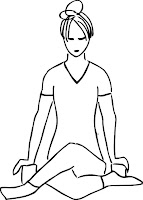Freedom has been the lesson I keep returning to this week, (not coincidentally) timed with the country’s celebration of its freedom from a relationship that did not work to the advantage of the colonies nor the English. I have explored many ways to deepen the feeling of freedom, or moksha (liberation), on the mat that have followed me off the mat.
Some students requested that we work on hip openers for our Independence Day practice. We worked to soften through the hips and pelvis to find a sense of ease in several asanas (poses), including gomukhasana (cow face pose) and in many lunges and standing poses including parivrtta trikonasana (revolved triangle pose). We worked toward eka hasta bhujasana (elephant trunk pose) and astavakrasana (eight-angle pose). But these two are not easy poses. Many students did not get into them and some of the students that did were unable to hold the poses for five breaths. This is where we are presented with the opportunity to free ourselves from our egos. Difficult poses like these offer important lessons to let go of the ego that tells us we need to “nail” each pose and let us explore the pose and experience it as our bodies offers it at this point in time. We are free to develop our practice and our attention as we challenge ourselves – where is the opportunity to develop if we never practice a pose we find difficult?
Many yoga students are challenged by hip openers like these. Others find these poses easier and need to explore freeing their egos in other poses such as shoulder openers like garudasana (eagle pose) and arm balances such as bakasana (crow pose). Whatever our challenge pose is at the moment, it will challenge us emotionally and mentally as much as it will challenge us physically. The challenging pose will become easier if we surrender into it and soften our resistance, using our breath to move into it, rather than pushing, expecting, trying and doing.
So where have I applied these lessons to my life off the mat? As a chronic perfectionist, I’ve been working on freedom from finding perfection in myself, others, and events. It is not easy for me to let go of my ego that I wrap in perfectionism. But I am more aware of softening expectations, looking for the best possible outcome perhaps, but finding something natural and generally ok about imperfection. I’ve been lengthening my breath and releasing resistance to what is and accepting it with a free and open mind. Just as every asana isn’t going to be perfect, nor will every action off the mat. If I accept freedom to experience fluctuation on my mat then I need to soften and release perfectionism off my mat.
We find more opportunities to liberate ourselves by releasing habitual thoughts and actions. Habits by definition are the easy way to function and lead to our reaching for a less healthy food option or automatically finding the negative in someone or something. It requires more mindfulness to interrupt a habitual pattern by reaching for a peach rather than a chocolate bar when we feel stress. It is hard work, but that is where the opportunity to develop ourselves comes from. True freedom comes from controlling and interrupting patterns and habits that don’t serve us. The founders of our country declared independence from patterns that didn’t serve the colonies. The freedoms they sought did not come easy but were rewarding, liberating, and enduring much as the benefits of our yoga practice can be for us. If we could only surrender and let go of our ego then we can be free.



